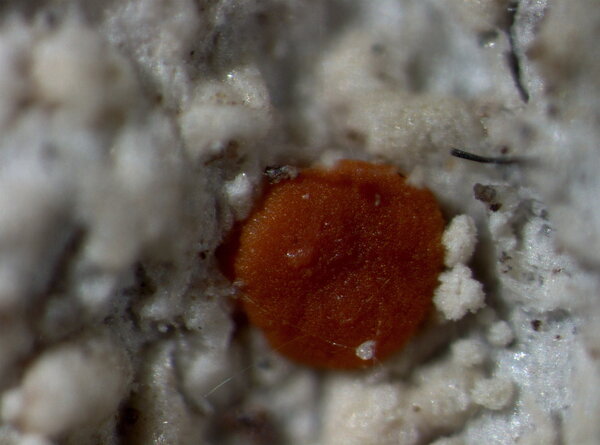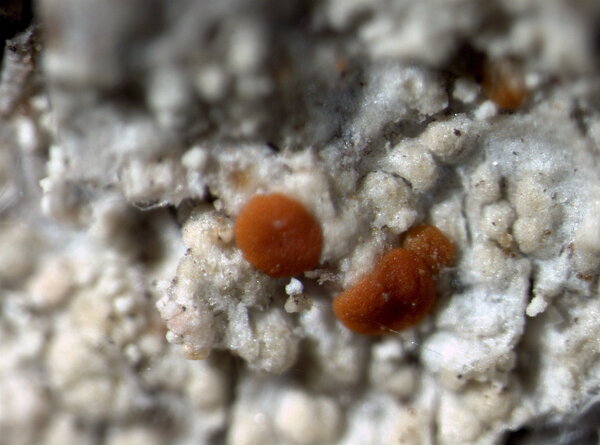Ramboldia cinnabarina (Sommerf.) Kalb, Lumbsch & Elix
Nova Hedwigia, 86: 32, 2008. Basionym: Lecidea cinnabarina Sommerf. - K. Svenska Vetensk.-Akad. Handl.: 114, 1824.
Synonyms: Biatora cinnabarina (Sommerf.) Fr.; Protoblastenia cinnabarina (Sommerf.) Räsänen; Pyrrhospora cinnabarina (Sommerf.) M. Choisy
Distribution: N - Ven (Caniglia & al. 1999), Piem (Isocrono & al. 2004), Lig.
Description: Thallus crustose, smooth to verruculose, ochraceous white to bluish grey-brown in sun-forms, with 0.2-0.5(-0.7) mm wide, rounded to irregular, white to cream-coloured, flat to slightly convex soralia (most abundant in sterile thalli). Apothecia lecideine/biatorine, 0.3-0.6(-1) mm across, broadly adnate, with an orange-red to blood-red, flat to convex disc and a soon excluded, thin proper margin. Proper exciple prosoplectenchymatous, of radiating, branched and anastomosing hyphae, orange in outer part, colourless within, the pigmented parts K+ red, granular-inspersed; epithecium orange-red, with an epipsamma of fine golden yellow granules reacting K+ red; hymenium colourless 60-80(-100) μm high, the upper part inspersed with yellow crystals, I+ blue; paraphyses coherent, simple or sparingly branched in upper part, not swollen at tips; hypothecium thick, colourless or pale orange brown. Asci 8-spored, clavate, the tholus with a strongly amyloid lateral part, a non-amyloid broadly diverging axial mass with a thick, non-amyloid cap above, and a weakly amyloid outer layer Lecanora-type. Ascospores 1-celled, hyaline, oblong to ellipsoid, (8-)10-12(-15) x 2-4 μm. Photobiont chlorococcoid. Spot tests: cortex and soralia, K+ yellow to yellow-brown, C-, KC-, P+ orange-red; apothecia K+ red. Chemistry: thallus with fumarprotocetraric acid, especially in the soredia; apothecia with atranorin and russulone.Note: a mainly subarctic-subalpine, circumpolar species found on the smooth bark of small shrubs in the subalpine belt, usually near the ground; overlooked, being often sterile. A dubious earlier record from Marche (see Nimis 1993: 592), and a more recent one from Sardinia by Zedda (2002, on twigs of Quercus ilex) are not accepted here.
Growth form: Crustose
Substrata: bark
Photobiont: green algae other than Trentepohlia
Reproductive strategy: mainly sexual
Commonnes-rarity: (info)
Alpine belt: absent
Subalpine belt: rather rare
Oromediterranean belt: absent
Montane belt: very rare
Submediterranean belt: absent
Padanian area: absent
Humid submediterranean belt: absent
Humid mediterranean belt: absent
Dry mediterranean belt: absent

Predictive model
Growth form: Crustose
Substrata: bark
Photobiont: green algae other than Trentepohlia
Reproductive strategy: mainly sexual
Commonnes-rarity: (info)
Alpine belt: absent
Subalpine belt: rather rare
Oromediterranean belt: absent
Montane belt: very rare
Submediterranean belt: absent
Padanian area: absent
Humid submediterranean belt: absent
Humid mediterranean belt: absent
Dry mediterranean belt: absent

Predictive model
 Index Fungorum
Index Fungorum
 GBIF
GBIF





